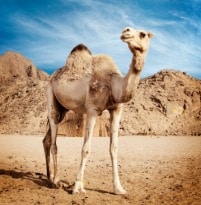When someone first mentioned camel milk to me, I thought they were joking. I asked myself, "Why would anyone want to consume a drink from an animal that lives in a parched dessert?" This was much before I woke up to the fact that it is now being considered as the newest health tonic.Long ago, bedouin and nomad cultures are known to have survived solely on camel milk for days. As a matter of fact, Pakistani and Afghani camels are believed to produce the highest yields. While Middle East brims with camel dairies, the Food Safety and Standards Authority (FSSAI) has not yet legalized its sale in India. But, the camel-rearing Rebari community in Rajasthan has been milking and consuming a substantial quantity for a while now.What's so super about it?
When you scan through the long list of benefits, you are likely to get tempted to take the plunge.• 3 times more Vitamin C than cow's milk and 10 times higher in iron
• Lower cholesterol than cow or goat's milk
• High unsaturated fatty acids and Vitamin B
• Lower in lactose than cow's milk (great alternative for those with lactose intolerance)
• Low in fat and light on the stomach
• High mineral and immunoglobulin content. Immunoglobulin is an anti-body used by the immune system to identify and neutralize bacteria and viruses.Does it help with diabetes and autism?Camel milk packs a bunch of qualities and wears the healthy halo comfortably. A previous study published in the Journal Evidence-Based Complementary and Alternative Medicine; found that 25 autistic children who consumed camel milk had lower levels of oxidative stress, which plays an important role in several neurological disorders. The children also showed a significant improvement in their behavior which goes to prove camel's milks therapeutic benefits. The anti-inflammatory properties are known to improve the brain function.As far as diabetes is concerned, camel milk is known to be a great source of an insulin-like protein that easily passes through the stomach without being destroyed. A study done by India's Bikaner Diabetes Care Research Center examined the effects of camel milk on type 1 diabetics. The participants consumed 500ml of fresh camel milk daily. The study concluded that it significantly reduced the insulin dosage required to regulate the blood sugar levels in the body. In fact, the Rebari community in Rajasthan has been using camel milk for several years to treat diabetes and even malaria.How does it taste?It has a slight salty undertone with an earthy taste. It is very refreshing and lighter than cow's milk. Sometimes it may be a bit watery. But here's the catch - it is best served fresh and raw. The concept of alternate milk beverages is slowly making newer varieties slip into our refrigerators. But, since most of these may give your wallet a good workout one should be cautious before lapping up a new trend.
When you scan through the long list of benefits, you are likely to get tempted to take the plunge.• 3 times more Vitamin C than cow's milk and 10 times higher in iron
• Lower cholesterol than cow or goat's milk
• High unsaturated fatty acids and Vitamin B
• Lower in lactose than cow's milk (great alternative for those with lactose intolerance)
• Low in fat and light on the stomach
• High mineral and immunoglobulin content. Immunoglobulin is an anti-body used by the immune system to identify and neutralize bacteria and viruses.Does it help with diabetes and autism?Camel milk packs a bunch of qualities and wears the healthy halo comfortably. A previous study published in the Journal Evidence-Based Complementary and Alternative Medicine; found that 25 autistic children who consumed camel milk had lower levels of oxidative stress, which plays an important role in several neurological disorders. The children also showed a significant improvement in their behavior which goes to prove camel's milks therapeutic benefits. The anti-inflammatory properties are known to improve the brain function.As far as diabetes is concerned, camel milk is known to be a great source of an insulin-like protein that easily passes through the stomach without being destroyed. A study done by India's Bikaner Diabetes Care Research Center examined the effects of camel milk on type 1 diabetics. The participants consumed 500ml of fresh camel milk daily. The study concluded that it significantly reduced the insulin dosage required to regulate the blood sugar levels in the body. In fact, the Rebari community in Rajasthan has been using camel milk for several years to treat diabetes and even malaria.How does it taste?It has a slight salty undertone with an earthy taste. It is very refreshing and lighter than cow's milk. Sometimes it may be a bit watery. But here's the catch - it is best served fresh and raw. The concept of alternate milk beverages is slowly making newer varieties slip into our refrigerators. But, since most of these may give your wallet a good workout one should be cautious before lapping up a new trend.
Advertisement






